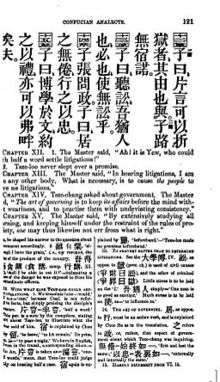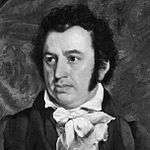James Legge
| James Legge | |||||||||||
|---|---|---|---|---|---|---|---|---|---|---|---|
 Missionary to China | |||||||||||
| Born |
20 December 1815 Huntly, Aberdeenshire, Scotland | ||||||||||
| Died |
29 November 1897 (aged 81) Oxford, England | ||||||||||
| Alma mater | King's College, Aberdeen | ||||||||||
| Religion | Congregationalist | ||||||||||
| Chinese name | |||||||||||
| Chinese | 理雅各 | ||||||||||
| |||||||||||
James Legge (/lɛɡ/; 20 December 1815 – 29 November 1897) was a Scottish sinologist, missionary, and scholar, best known as an early and prolific translator of Classical Chinese texts into English. Legge served as a representative of the London Missionary Society in Malacca and Hong Kong (1840–1873) and was the first Professor of Chinese at Oxford University (1876–1897). In association with Max Müller he prepared the monumental Sacred Books of the East series, published in 50 volumes between 1879 and 1891.
Life
James Legge was born at Huntly, Aberdeenshire. He enrolled in Aberdeen Grammar School at age 13[1] and then King's College, Aberdeen at age 15.[2] After studying at the Highbury Theological College, London, he went in 1839 as a missionary to China, but remained at Malacca three years, in charge of the Anglo-Chinese College there. The College was subsequently moved to Hong Kong, where Legge lived for nearly thirty years. A Chinese Christian, Wat Ngong, accompanied Legge when he moved in 1844. He returned home to Huntly, Aberdeenshire, in 1846–7, taking with him three Chinese students. Legge and the students were received by Queen Victoria before his return to Hong Kong.

Legge married twice, first to Mary Isabella Morison (1816–1852) and after she died to a widow, Hannah Mary Willetts (d 1881, née Johnstone).
Translating the classics
Convinced of the need for missionaries to be able to comprehend the ideas and culture of the Chinese, he began in 1841 a translation in many volumes of the Chinese classics, a monumental task that he completed a few years before his death. During his residence in Hong Kong, he translated Chinese classic literature into English with the help of Wang Tao and Hong Rengan, among others. He was appointed headmaster of Ying Wa College in Malacca in 1839 and continued in that position until 1867, the college having removed to Hong Kong in 1844. He was pastor of the Union Church in Hong Kong from 1844 to 1867.
He was third and final editor of the Chinese Serial, the first Chinese newspaper in Hong Kong. The paper closed in May 1856.
In 1867, Legge returned to Dollar in Clackmannanshire, Scotland, where he invited Wang Tao to join him, and received his LLD from the University of Aberdeen in 1870. While in Scotland, he also revisited his native burgh, Huntly, accompanied by Wang Tao. He then returned to Hong Kong as pastor at Union Church from 1870 to 1873. While in Hong Kong he published The She King (Classic of Poetry) in 1871 which according to Peter France is the first substantial volume of Chinese poetry in English translation still in use. The work underwent a new edition in 1876 in verse.[3]
He took a long trip to North China, beginning 2 April 1873 in Shanghai, arriving at Tianjin by boat, then travelling by mule cart and arriving in Peking on 16 April 1873, where he stayed at the London Missionary Society headquarters. He visited the Great Wall, Ming Tombs and the Temple of Heaven, where he felt compelled to take off his shoes with holy awe. He left Peking, accompanied by Joseph Edkins, and headed for Shandong by mule cart to visit Jinan, Taishan, where they ascended the sacred Mount Tai, carried by four men on chairs. Leaving Mount Tai on 15 May, they visited Confucius Temple and the Forest of Confucius at Qufu, where he climbed to the top of Confucius' burial mound. Legge returned to Shanghai by way of the Grand Canal, and thence to England via Japan and the USA in 1873.[4]
Oxford professor
In 1875 he was named Fellow of Corpus Christi College, Oxford and in 1876 assumed the new Chair of Chinese Language and Literature at Oxford, where he attracted few students to his lectures but worked hard for some 20 years in his study at 3 Keble Terrace, on his translations of the Chinese classics. According to an anonymous contemporary obituary in the Pall Mall Gazette, Legge was in his study every morning at three o'clock, winter and summer, having retired to bed at ten. When he got up in the morning the first thing he did was to make himself a cup of tea over a spirit-lamp. Then he worked away at his translations while all the household slept.
Legge was an ardent opponent of Britain's opium policy, and was a founding member of the Society for the Suppression of the Opium Trade.[5]
In addition to his other work Legge wrote The Life and Teaching of Confucius (1867); The Life and Teaching of Mencius (1875); The Religions of China (1880); and other books on Chinese literature and religion.
Legge was given an honorary MA, University of Oxford, and LLD, University of Edinburgh, 1884. Legge died at Oxford in 1897 and is buried in Wolvercote Cemetery. Many of his manuscripts and letters are archived at the School of Oriental and African Studies.[6]
Selected works

Legge's most enduring work has been The Chinese Classics: with a Translation, Critical and Exegetical Notes, Prolegomena, and Copious Indexes, 5 vols., (Hong Kong: Legge; London: Trubner, 1861–1872):
- Volume 1: Confucian Analects, the Great Learning, and the Doctrine of the Mean (1861). Revised second edition (1893), Oxford: Clarendon Press, reprinted by Cosimo in 2006 (ISBN 978-1-60520-643-1). The Confucian Analects
- Volume 2: The works of Mencius (1861), Revised second edition (1895), Oxford: Clarendon Press, reprinted by Dover Books in 1990 (ISBN 978-0-486-26375-5).
- Volume 3: The Shoo King (Book of Historical Documents) (1865):
- Part 1: Prolegomena (with Bamboo Annals) and Chapters 1–36
- Part 2: Chapters 37–58 and indexes
- Volume 4: The She king (Classic of Poetry) (1871)
- Volume 5: The Ch'un ts'ew (Spring and Autumn Annals), with the Tso chue (Commentary of Zuo) (1872)
These contain parallel Chinese and English text, with detailed notes, introductions and indexes. Chinese names are transcribed in Legge's own romanisation.
Legge originally planned his Chinese Classics as seven volumes, but his translations of the I Ching and Book of Rites (and several others) were instead included in the Sacred Books of the East series edited by Max Müller (Oxford: Clarendon Press):
- Volume 3: The Shû king (Book of Documents). The religious portions of the Shih king (Classic of Poetry). The Hsiâo king (Classic of Filial Piety). (1879)
- Volume 16: The Yî king (I Ching) (1882)
- The Lî Kî (Book of Rites) (1885), 2 vols.:
- The Texts of Taoism: The Tâo Teh King (Tao Te Ching); The Writings of Kwang-dze (Chuang Tzŭ) (1891), 2 vols.:
- Volume 39: Tao Te Ching and Chuang Tzŭ books 1–17.
- Volume 40: Chuang Tzŭ books 18–33 and shorter works: the Taishang Ganying Pian (Tractate of Actions and their Retributions), the Qingjing Jing (Classic of Purity), the Yinfujing (Classic of the Harmony of the Seen and Unseen), the Yushu Jing (Classic of the Pivot of Jade) and the Nei Riyong Jing (Classic of the Directory for the Day).
Other works:
- The religions of China: Confucianism and Tâoism described and compared with Christianity, London: Hodder and Stoughton, 1880.
- The Nestorian monument of Hsî-an Fû in Shen-hsî, China, London: Trübner & co., 1888; repr New York: Paragon Book, 1966, ISBN 978-0-8188-0062-7. (Contains Chinese-English parallel.)
Notes
- ↑ Pfister (2004), p. 47
- ↑ Pfister (2004), p. 64
- ↑ Peter France (2001). "East Asian Languages: Chinese Poetry". The Oxford Guide to Literature in English Translation. Oxford University Press. p. 224. ISBN 978-0-19-924784-4.
- ↑ (N. J. Girardot 2002, pp. 83–97)
- ↑ (N. J. Girardot 2002, p. 196)
- ↑ 'James Legge – A short biography' in: Forbes, Andrew; Henley, David (2012). The Illustrated Tao Te Ching. Chiang Mai: Cognoscenti Books. ASIN: B008NNLKXC
References
 This article incorporates text from The religions of China: Confucianism and Tâoism described and compared with Christianity, by James Legge, a publication from 1880 now in the public domain in the United States.
This article incorporates text from The religions of China: Confucianism and Tâoism described and compared with Christianity, by James Legge, a publication from 1880 now in the public domain in the United States.- Forbes, Andrew; Henley, David (2012). The Illustrated Tao Te Ching (Jamese Legge translation). Chiang Mai: Cognoscenti Books. ASIN: B008NNLKXC
- N. J. Girardot (2002). The Victorian Translation of China: James Legge's Oriental Pilgrimage. University of California Press. ISBN 978-0-520-21552-8.
- Lauren F. Pfister, Striving for 'The Whole Duty of Man': James Legge and the Scottish Protestant Encounter with China, 2 vols., published by The Scottish Studies Centre of the Johannes Gutenberg Universität Mainz in Germersheim, 2004.
- Legge, Helen Edith (1905). James Legge, Missionary and Scholar, London: Religious Tract Society.
Further reading
- Endacott, G. B. (2005) [1962]. A biographical sketch-book of early Hong Kong. Hong Kong University Press. ISBN 978-962-209-742-1.
External links
- Works by James Legge at Project Gutenberg
- Works by or about James Legge at Internet Archive
- Works by James Legge at LibriVox (public domain audiobooks)

- Chinese Classics of the "Sacred Books of the East" most of which were translated by Legge
- Smith, Carl (1986), "A sense of history (Part I)", Journal of the Royal Asiatic Society Hong Kong Branch 26: 144–264.
- “The Tao Teh King, or The Tao and its characteristics”, English translation by James Legge. Scalable text on white, grey or black background. Downloadable as a .txt file.
- James Legge and the Confucian Classics: Brilliant Scot in the Turmoil of Colonial Hong Kong. 2015. By Marilyn Bowman. An eBook downloadable as a .pdf file.
